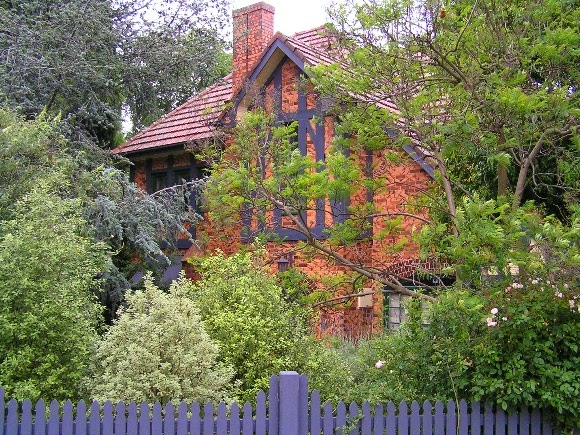Marvellous Camberwell Heritage Houses
Table of Contents
- See also Tara Estate Camberwell
|
Stratford |
Kantara |
Warranbine |
608 Riversdale Road, |
|
9 Kintore Street |
10 MURDOCH STREET, |
3 Berwick Street |
18 Kintore Street |
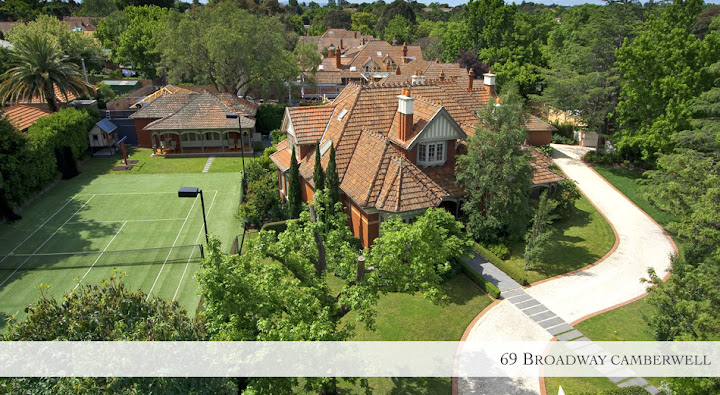 Wee Nestie, 69 Broadway, CAMBERWELL |
 608 Riversdale Road CAMBERWELL |
Camberwell Conservation Study 1991
Significance of the City
Few places portray the ideals of Australian suburban life as clearly as Camberwell. For better or worse, the suburb lies at the heart of Australian life, and Camberwell is the classic suburb. It has been populated by the middling and upper social strata, living in detached single-family dwellings set amidst gardens and trees.
- Camberwell is tied to the city by public transport yet apart from it, having successfully excluded the dirty, nasty and dangerous elements of urban life.
- Only churches and shops were welcomed as appropriate additions to its domestic landscape. More successfully than most other Australian municipalities, Camberwell has created the suburban ideal of country in the city and deliberately maintained this character for more than one hundred years.
- All of the most desirable suburban characteristics of the period between 1860 and 1960 are expressed in the buildings and streets of Camberwell. Most importantly, Camberwell clearly displays the aspirations and the material forms of the suburban world created between the First and Second World Wars.
- The historic significance of Camberwell lies in the quality, variety, and completeness of the municipality’s essentially suburban appearance. Individual buildings and areas within the suburb clearly register the key aspects of thissuburban form. Most important amongst these are:
Slideshow of Camberwell Heritage Homes
 |
| 18 Stanhope Grove, Camberwell |
1. Large, often multi-storeyed mansions built prior to the railway boom of the 1880’s and established with their own work force, gardens, orchards and livestock just beyond what was then the boundary of the Melbourne metropolitan area.
2. Detached villas, often architect-designed, and built for upper-middle clients between 1880 and 1914. These are clustered around public transport routes, particularly the east-west railway link to the city.
3. The estates of detached middle-class housing created between the wars essentially tied to fixed-rail electric transport. These houses include superior examples of the whole range of exotic and nostalgic styles which coloured Australian suburbia during the period.
Camberwell always took pride in its “natural” qualities. From the l870s onwards, streets have been planted with a succession of street trees, first of all exotic and subsequently native. Councillors, council staff and local residents have fought for parks and gardens, both ornamental and recreational in the suburb. These natural elements set the seal on Camberwell’s distinctive suburban quality.
Especially in the inter-war period, Camberwell boasted of its superior suburban qualities. Its buildings, public spaces, general lay-out and exclusion of unwanted activities all demonstrated the essence of suburbanism, the dominant characteristic of the most modern cities, in Australia and indeed in the remainder of the world.
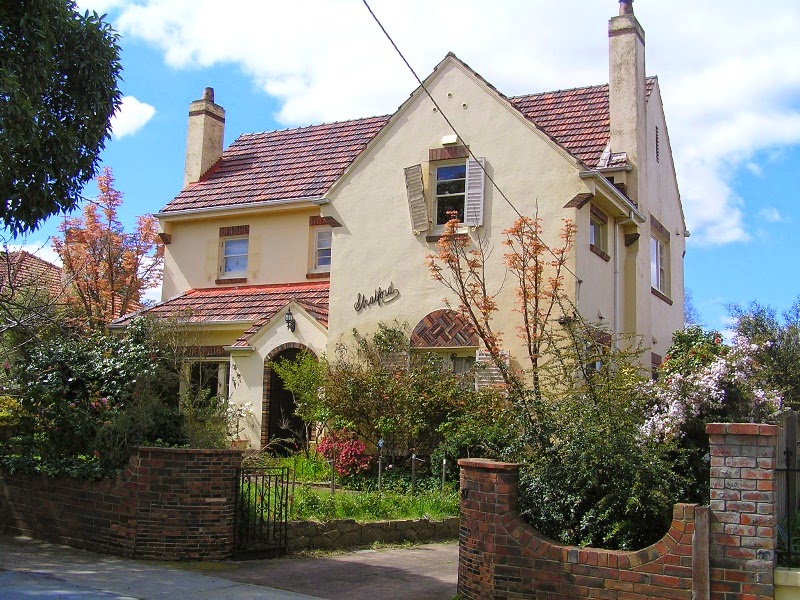 |
| Stratford, 87-87A Bowen Street CAMBERWELL |
Camberwell’s estates were planned to a more lavish scale than in many other suburbs. Its developers made sure that public amenities measured up to the quality of its individual houses; these houses often expressed the best in contemporary style and as detached single-storeyed villas,
Stratford
87-87A Bowen Street CAMBERWELL, Boroondara City
Google Maps and Google Streetview
Heritage Overlay Number
HO371
Statement of Significance
Stratford, the house at 87-87A Bowen Street Camberwell, is of local historical and architectural significance. In terms of its size, form, and general composition the house is typical of many comfortable middle-class interwar Camberwell residences. It is distinguished from other examples, however, by its combination of typical 1930s eclectic design with a restrained plainness of exterior finish, sparing placement of doors and windows, and consciously modernist horizontal glazing bars.
William Halsey house, (Wee Nestie) 69 Broadway, CAMBERWELL, 3124(1900-1)
View an extensive photographic gallery here
 |
Wee Nestie is placed askew on its owner site, it is aligned, unlike its neighbours, neither perpendicularly nor diagonally to the street. A large indented gateway was at a comer splay in the allotment and an asphalt tennis court on the west of the house.
- Architects, Ussher & Kemp, designed this nine room Queen Anne styled house for importer, William Halsey in 1900.
- G. Garrett was the builder. Later owners included J.R Wood and P.R Kershaw; the latter converting, Wee Nestie to Karinyah private hospital in 1959.
- Typically multi-bayed and verandahed in plan, the house is also one and two-storey height: using both two and three-dimensional variations to achieve an optimum picturesque composition.
- A chimney shaft which bisects a roof gable-end is a device also seen at other Ussher and Kemp houses,(i.e. 5 Willsmere Road Kew), adorned here with a cement pediment which is typical of one of the style’s sources, the English Queen Anne.
- Ussher had used this distinctive device much earlier, in the Cottage by the Sea, at Queenscliff (1892), also in the Foden house at Canterbury (1897).
Other typical Queen Anne attributes are present:
- the half- timbered multi-gabling set against a high, hipped roof,
- the Marseilles pattern roof tiles, red brick and stucco walls,
- and an arcaded and slatted timber verandah.
Atypical however is Ussher and Kemp’s skillful and less frenetic placement of mass and openings to achieve their picturesque aims.
A new pavilion wing has been added to match on the eastern side and, although too close a replication of the original, it is far more successful than the unfortunate wing on the west. Mature shrubs and asphalt paving fit the period.[22]
- “Saw an amazing house with Mal this week at 69 Broadway in Camberwell. This is listed by Doug McLauchlan of Marshall White under an Expressions of Interest campaign, quoting $7m plus.
- “We were not sure about this property from the outset – the main concern being that it did not seem to have any real ‘backyard’ area. Mal has a saying with these grand homes that ”they are bit like the Grand Lady without the fine skirt”, meaning that they don’t have the commensurate land where you want it in private areas ( ie the backyard) or land has been taken away or subdivided off, to complement the large house.
- “The house is very good and has been wonderfully renovated; it has a fantastic feel internally and the rear yard area does seem to work quite well. The open plan living area is very good, and the way the kitchen can be screened off is very clever, I thought.”[23]
Cupples house, now Travancore, at 104 (now 608) 608 Riversdale Road CAMBERWELL (1899)
“Ussher & Kemp Grandeur”
 608 Riversdale Road CAMBERWELL |
608 Riversdale Road CAMBERWELL |
608 Riversdale Road CAMBERWEL |
608 Riversdale Road CAMBERWELL |
“This perfect example of a gracious residence standing on a cul-de-sac, corner showcasing lavish architectural allure behind sun-filled garden is undoubtedly one of the BEST.
- This magnificent Federation Queen Anne residence is Ussher & Kemp at their glorious best masterfully merging with stunning contemporary enhancement.
- A brilliant alfresco oasis with solar heated pool complements the romantic exterior complexity characteristic of Australia’s pre-eminent architects for enviable family living”[17]
Indicative locality:
“Talarno” c1890, 18 Kintore Street CAMBERWELL
Sold $2,703,000 in 22 Feb 2014
Sold $1,860,460 in 18 Aug 2012
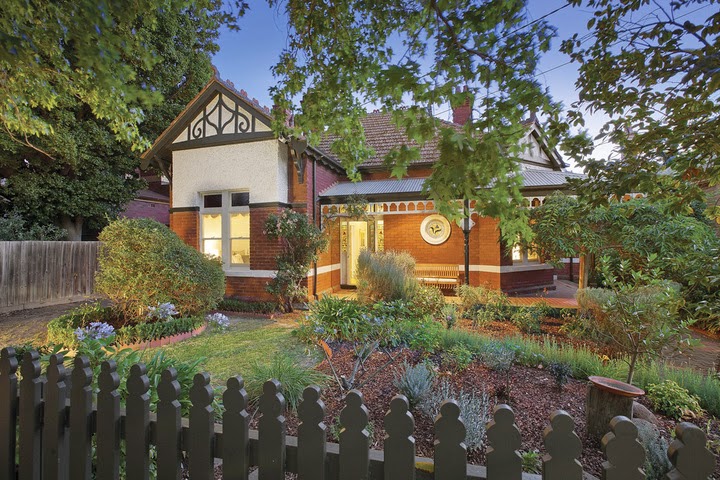 |
 |
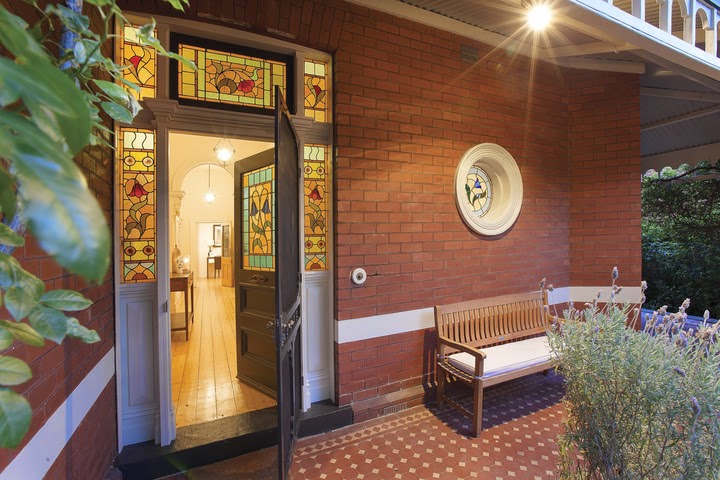 |
 |
A picture of Edwardian elegance in one of the Tara Estate’s most tightly held streets, “Talarno” is a period residence in a gorgeous garden setting offering exceptional formal and family living.
- Perfectly located just a few minute’s walk from Burke Road cafes, shops, restaurants and transport options, plus easy access to many of Melbourne’s finest schools. The recently refurbished interior boasting generously proportioned rooms is introduced by a tessellated return verandah and showcases coloured leadlight glass and decorative ceilings. A double-arched hallway opening to a formal sitting & dining room with classic timber over mantle, five bedrooms, two with box bay windows, period-style bathroom and sky lit study area.
- Astonishingly, there were seven bidders at this Hamish Tostevin auction. The property’s many strengths were reinforced during Mr Tostevin’s preamble which touched on points including location and proximity to many amenities. When the call for bids was made, a strong $2,000,000 was offered but deemed too low by Mr Tostevin
 |
 |
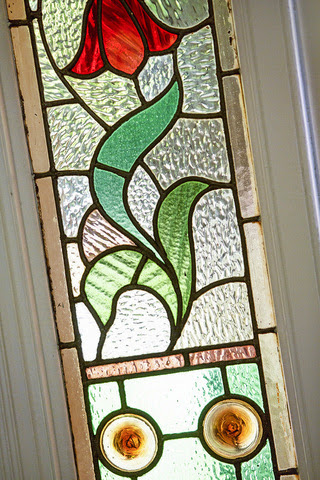 |
- The recently refurbished interior boasting generously proportioned rooms is introduced by a tessellated return verandah and showcases coloured leadlight glass and decorative ceilings.
- A double-arched hallway opening to a formal sitting & dining room with classic timber over mantle, five bedrooms, two with box bay windows, period-style bathroom and sky lit study area. A rear extension includes a laundry/2nd bathroom, generously proportioned light-filled Smeg appointed kitchen and family living with floor-to-ceiling windows and surround verandah leading to a brick paved entertaining area and pavilion with built-in gas barbeque, sink and garden storage.[1]
49 Cookson Street Camberwell Vic
Federation/Edwardian Interiors
 |
|
 |
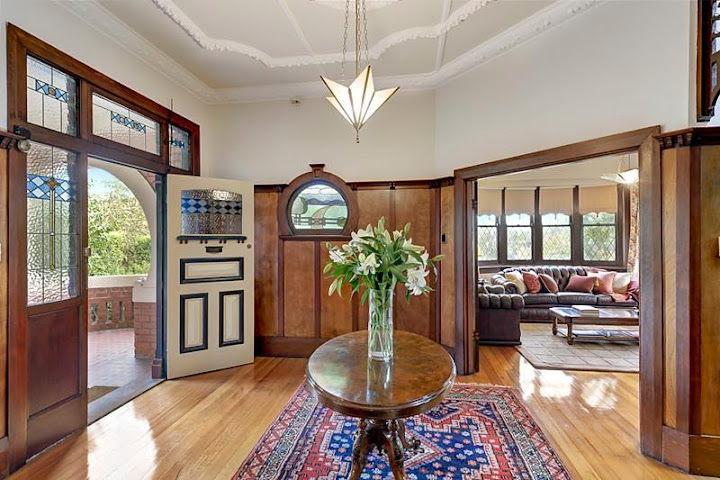 |
Heritage Search Results of The **Victorian Heritage Database**
 |
Doneraile15 Alma Road CAMBERWELL, Boroondara View Details |
Doneraile is of local historical and state architectural significance. Designed by architect Evander McIver and constructed in 1890-91, Doneraile is a prototype for the emerging Federation villa. Its asymmetrical planning, strapwork chimneys, plain brick walling, pyramidal slate roof and Japanese turned timber detailing are all Federation characteristics, but were seen in combination in only a few houses prior to 1890. It is one of a limited number of prototypes that appeared in Melbourne during the period 1889-1892.
|
Boroondara City |
||
 |
Thomas Gaggin House 25 Alma Road CAMBERWELL, Boroondara View Details |
The Thomas Gaggin House is of local historical and architectural significance a representative and externally generally intact example of a substantial late Victorian Italianate villa, at a size comparatively rare in Camberwell. The Thomas Gaggin Houseis a skilled example of design in a two-toned brick Italianate style, typifying contemporary work by the prominent Melbourne architects Oakden, Addison and Kemp. |
Boroondara City |
||
 |
33 – 35 Alma Road 33 – 35 Alma Road CAMBERWELL, BOROONDARA View Details |
33 Alma Road, Camberwell is of historical and architectural significance as a fine and externally relatively intact example of an asymmetrical stuccoed Victorian Italianate villa with tower. It is distinguished architecturally from other examples by its quiet but consistent re-scaling of otherwise conventional Italianate elements, effectively enlarging the presence of the house. |
Boroondara City |
||
|
Glenholme; Ngarwee |
Glenholme; Ngarwee36 – 38 Alma Road CAMBERWELL, BOROONDARA View Details |
Glenholm is of local historical and architectural significance as a representative and relatively externally intact example of a suburban Italianate brick villa of the late 1880s which is distinguished by its decorative dichrome brickwork. Its canted bay, slate roof, verandah with decorative lacework, and frontality on its site all mark the house as typical of the later period of nineteenth century suburban Italianate. While a fairly conservative design in general, Glenholm exhibits a high degree of consistency and richness in its main street presentation, and has an individuality which derives from the vigorous voussoir patterning of its dichrome brick. |
Boroondara City |
||
 |
Rathmore; Rokeby78 Athelstan Road CAMBERWELL, Boroondara View Details |
Rokeby at 78 Althestan Road, Camberwell, is of municipal significance. Rokeby is an early and externally relatively intact example of a mature Federation design and is one of a relatively small group of houses that announced Federation architecture’s complete arrival in the domestic sphere. Rokeby’s site placement, angled corner bay, and placement of a pyramidal roof form punctuated by projecting sitting room and dining room bays, is a clear and mature reflection of the external massing that would mark the Federation period. Its pinwheel placement of rooms around a central hall became thoroughly characteristic of internal planning in the Federation period. Rokeby is quite closeto the seminal Federation plans by Alfred Dunn and Beverley Ussher of 1889-1892. The house also has a directness that presages later moves around Australia toward simpler bungalow composition. The sitting room bay canopy is unusual in Victoria in its combination of scalloped window hood and brackets, and the roof bracket to the north east corner predates a later bungalow characteristic. In general the design is rich in its combination of form and materials, yet plain and vigorously executed, externally. 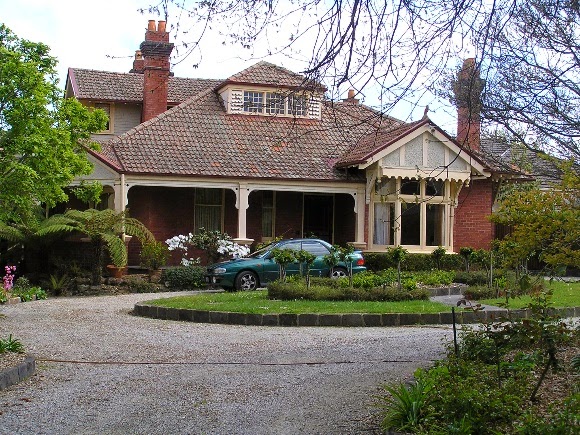 Description
|
Boroondara City |
||
 |
Stratford87-87A Bowen Street CAMBERWELL, Boroondara View Details |
Stratford, the house at 87-87A Bowen Street Camberwell, is of local historical and architectural significance. In terms of its size, form, and general composition the house is typical of many comfortable middle-class interwar Camberwell residences. It is distinguished from other examples, however, by its combination of typical 1930s eclectic design with a restrained plainness of exterior finish, sparing placement of doors and windows, and consciously modernist horizontal glazing bars. Description Stratford, the house at 87-87A Bowen Street, Camberwell is broadly intact, externally, and has been maintained in general sympathy with its original materials and form. The house is double-fronted and bracketed, compositionally, with two tall cement-rendered chimneys. The roof is steeply pitched and clad in terra cotta Marseilles pattern tiles over its main and projecting wings, with a shallower skillion tiled roof over a ground floor bedroom and entry hall. The porch is formed by a gabled pavilion jutting from this skillion, and is entered through a stilted segmental arch dressed in tapestry brick. Similar brick dresses the bedroom window lintels, a semicircular panel over the ground floor lounge window, and six corbels under the larger gables. The west wing windows both have shutters, but the other windows were all plain insets, most with modernist horizontal glazing bars. The house was divided into flats in 1950,[i] when a flat roofed bedroom was added to the ground floor at the south-east corner. The drawing for these works shows a new external stair to be constructed on the north elevation providing access to the first floor flat. The fence is in clinker brick and may be original (albeit altered); an inlay of Roman tapestry brick laid in curves frames the gate and appears to be later, possibly dating from when the house was converted into flats in 1950. The concrete drive looks to be of a similar age. [i] Details sourced from the City of Camberwell Building Index, #4705, dated 27 April 1950. |
Boroondara City |
||
 |
Stratford 458 CamberwellRoad CAMBERWELL, Boroondara View Details |
Stratford, at 458 Camberwell Road, Camberwell, is of local historical and architectural significance as a fine and generally intact example of an interwar suburban residence combining contemporary Tudor references.
|
Boroondara City |
||
 |
Coolattie 29 Canterbury Road CAMBERWELL, Boroondara View Details |
Coolattie, at 29 Canterbury Road Camberwell, is of local historical and architectural significance. It is a handsome and relatively intact example of a substantial late Victorian residence in Camberwell combining a distinctive transversely proportioned and centralized plan form with a complex elevational treatment. The design is impressive in its control of scale and encompasses a broad range of detail spanning Italianate, Queen Anne and more distinctly Federation approaches. Coolattie’s combination of late Victorian Italianate and early Federation elements is found in numerous other villa residences in the immediate area, however, it is one of a smaller number of examples in Camberwell to bring this transitional approach to a more substantial house. |
Boroondara City |
||
 |
44 Currajong Avenue 44 Currajong Avenue CAMBERWELL, Boroondara View Details |
44 Currajong Avenue is of local historical and architectural significance as an interesting and distinctive example of a bungalow constructed in the period immediately following WWI. While in its planning and general form 44 Currajong Avenue is characteristic of the bungalows constructed in subdivisions in south Camberwell in the period immediately following World War 1, it is one of the more elegant examples. The verandah appears to float in way not often seen in contemporary designs, and the house has a distinctive simplicity and balance in its materials and finishes. It is located in a streetscape and broader precinct (Sunnyside Estate) of relatively consistent interwar bungalow character. |
Boroondara City |
||
 |
Westralia 27 Inglesby Road CAMBERWELL, Boroondara View Details |
Westrailia, 27 Inglesby Road, Camberwell is of local historical and architectural significance as a representative and externally intact example of a late 1880s dichromatic Italianate house of a type relatively common in Boroondara. Located on a prominent corner site, it is distinguished by its relatively high level of external integrity and the survival of its original fence and gates. |
Boroondara City |
 |
Kantara622 Riversdale Road CAMBERWELL, Boroondara View Details |
Designed in 1891 by little-known architect, J Charlesworth, Kantara, 622 Riversdale Road, Camberwell, is of local historical and state architectural significance as an early example of Australian Federation villa design. Kantara shows all the frontal characteristics of an Australian Federation house, but does so in the earliest period of Federation architecture. As an early expression of the new Federation architecture, it is paralleled by relatively few other published designs. The design draws together a range of generally compatible themes; of particular note are the integral verandah roof and dramatized corner tower (cupola) expression, both usually only seen in much later Federation designs, and the detailing to its main bay. The building is intact as viewed from the street and has a sympathetic garden setting which may retain elements of an early garden layout. Description 622 Riversdale Road is a double-fronted brick residence with a return verandah, perched on a steeply banked site overlooking Riversdale Road. The roof is of terracotta tile in a Marseilles pattern, hipped in the main body and framed with a gabled wing at the north-east corner. It is punctuated by corbel-topped chimneys.
[i] Details sourced from the City of Camberwell Building Index, # 13920, dated 7 April 1954. |
Boroondara City |
||||
Warrawee626-8 Riversdale Road CAMBERWELL, Boroondara View Details |
Provisional only
Warrawee, at 626-628 Riversdale Road, Camberwell, is of local historical and architectural significance. It is a fine, representative and relatively externally intact example of the large, single storey Italianate villas which appeared in the Camberwell-Canterbury-Surrey Hills areas in the middle to late 1880s.
|
Boroondara City |
|||||
 |
660 Riversdale Road660 Riversdale Road CAMBERWELL, Boroondara View Details |
No. 660 Riversdale Road is of local historical and architectural significance as a substantial brick residence in the Old English manner.
|
Boroondara City |
||||
 |
899 Toorak Road 899 Toorak Road CAMBERWELL, Boroondara View Details |
Provisional Grading – to be reviewed 899 Toorak Road, Camberwell, is of local historical and architectural significance, as a fine and relatively externally intact example of a sophisticated Bungalow design from the early 1920s. Its asymmetrical composition is robust, elegant and powerful, and tending to the abstract in comparison with most local bungalow counterparts. It is also distinctive for its Japanese character. Description The house could not be described in detail as it is not visible from the street and access was not available during the course of the Review. The following description is based on existing documentation (Camberwell Conservation Study 1991 and drawings) and would need to be confirmed on site. The house is obscured from the street by a 2.5 metre high stained timber paling fence with galvanized steel gates. The upper section of the main gable, together with the clinker-brick chimney, is visible from the street, along with other elements of the roof. The roof is in its original terracotta tiles, and the gable has its original shingles and pattern of fascias, albeit repainted. |
Boroondara City |
||||
 |
931 Toorak Road931 Toorak Road CAMBERWELL, Boroondara View Details |
931 Toorak Road is of local historical and architectural significance. Architecturally, it is of significance as an intact and well-preserved example of a two-storey attic house in a popular Melbourne form following the US Bungalow pattern championed by Katherine Budd and Gustav Stickley.
 It is demonstrative of the influence of Eastern US house design on Bungalow forms in Melbourne in the 1920s, alongside better-known influences from California. The house retains its setting, including original fence and entry pergola, and is set in a dense garden. |
Boroondara City |
||||
 |
Warranbine125 Wattle Valley Road CAMBERWELL, Boroondara View Details |
Warranbine is of local architectural and historical significance as an early example in Camberwell of a large single-storey villa to adopt a style other than the Italianate, in this case a distinctively Old English mode. The design is distinguished by a strong, simple composition on its Wattle Valley Road frontage, which meshes well with its imposing and lush garden.
 Much of its interest derives from its early date of construction; appearing in the early 1890s and combining aspects of the developing Federation mode with elements of earlier approaches to design, as in its symmetry. The additions have been unobtrusive and are visibly sympathetic, although the overpainting of the exterior detracts from the presentation of the building.
The house was extended to the south and north in 1978, to designs by Richard Fakhry.[i] Other than for these works, the main alteration that has occurred is the overpainting of the exterior.
|
Boroondara City |
||||
|
10 Donna Buang Street |
10 Donna Buang Street 10 Donna Buang Street CAMBERWELL, Boroondara View Details |
Architecturally, a superb well-preserved Japanese inspired Californian Bungalow, with rare Malthoid or similar bituminous roof-cladding, early reinforced concrete walling and the distinctive low-gabled form which its use allowed, notable verandah details and a mature period landscape setting. Of the known examples of Perrott’s concrete Bungalows, this appears to be the best example as well as among the earliest group: of State importance. Almost taken straight from the Malthoid advertisements (Asbestos roofing), this Japanese inspired Californian Bungalow has all of the attributes of its type. Rubble field stone is used on the verandah piers and chimneys, the roof gables are low as allowed by its rare intact Malthoid roof cladding, the verandahs are wide and cavernous and possess stout timber posts and shingling is used for cladding. Enhancing the interplay of form,’ the house is set at an angle on the block |
Boroondara City |
||||
|
23 Sunnyside Avenue |
23 Sunnyside Avenue 23 Sunnyside Avenue CAMBERWELL, Boroondara View Details |
Architecturally, an outstanding, well-preserved and distinctive house design, skilfully adapting what appears to be an English Edwardian Freestyle inspiration, in a period landscape setting also a major contributor to an important Bungalow era estate: of State importance. Historically, interesting as the residence of Frank Le Leu, a prominent figure in local building activity: of regional interest. |
Boroondara City |
||||
|
608 Riversdale Road,
Sold Date: Sat 11-Aug-12 |
608 Riversdale Road608 Riversdale Road CAMBERWELL, Boroondara View Details |
Architecturally, a distinctive Queen Anne design by the style’s most adept architects which is sited within a contemporary streetscape; of regional importance. Historically, Stanmore’s first owner is typical of the class which has become associated with the Camberwell municipality.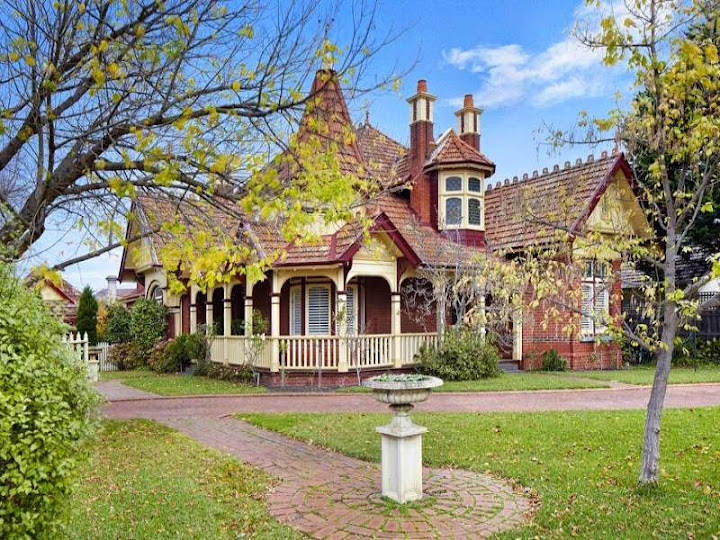 Description Freeland’s description is apt, given the evident intention to create a picturesque roof line and a plan which follows suit. Attic rooms had both the functional advantage of cheap second level space and the design advantage of potentially numerous roof shapes protruding from the archetypical hipped main roof.
|
Boroondara City |
||||
 Astolat Camberwell Oval Lawn |
Astolat 630 Riversdale Road CAMBERWELL, Boroondara View Details |
Architecturally, a large and externally near intact (?) example of a common 19th Century villa style which is greatly enhanced by its exotic and ornamental landscape setting; of regional importance. Historically, linked briefly with the Derham family but, as the first owners, very expressive of the tastes and expectations of their like both in choice of garden and home; of local importance and regional interest The name ASTOLAT is derived from Tennyson’s Idylls of the King. The beauty and grand scale of this garden certainly is fitting of the name. Many owners of the property have tended and enhanced the garden since its conception in 1882-1884. The name ASTOLAT is derived from Tennyson’s Idylls of the King. The beauty and grand scale of this garden certainly is fitting of the name. Many owners of the property have tended and enhanced the garden since its conception in 1882-1884.The carriage drive leads to an oval lawn that bows before the Victorian residence.
|
Boroondara City |
HO144 Burke Road Precinct, Hawthorn East
The Burke Road Precinct, Camberwell/Hawthorn East, is an area of heritage significance for the following reason:
- The stretch of residential development on Burke Road hill (south of Camberwell Junction) combines small numbers of Victorian and Federation houses with a series of interwar residences and flat blocks.
- These are interspersed with later development including undistinguished buildings of post-WWII period.
- The area has retained a consistent residential scale, despite being adjacent to a major retail and business centre and on a major road.
HO159 Prospect Hill Road Precinct, Camberwell
The Prospect Hill Road Precinct, Camberwell, is of heritage significance for the following reasons:
- The areas north of the railway line comprise a generally intact collection of late Victorian and Federation houses, all very well designed and with a high level of integrity to their gardens and street appearance. The precinct is one of the most intact and homogenous estates of this type in Melbourne, rivalling the Central Park – Stanhope Street region in Malvern and the other leading Boroondara concentrations of this period, the Grace Park Estate in Hawthorn (HO152) and the Barry Street Precinct in Kew (HO143). It is the foremost precinct of combined late Victorian-Federation building stock in the former Camberwell municipality.
- Many late Victorian and Federation houses in this area have been custom-designed, giving the precinct a distinct identity (this is particularly true for areas north of Prospect Hill Road). The area as a whole is marked by a general cohesion in scale, address of the streets, property dimensions, materials and detailing and fence height. Though there are variations, the streets have a general uniformity in their mature street tree coverage, basalt kerbs and pitching, asphalt foot paving, and driveway width. Within the general precinct heavy traffic volumes have been kept to four streets in three axes: Stanhope Grove-Trafalgar Road, Prospect Hill Road, and Broadway west. The Read Gardens, a small but mature park, is a central focal point.
The Tara Estate
The north-western section of the Prospect Hill Precinct, the former Tara Estate (bounded by the south side of Canterbury Road, the east side of Loch Street, the south side of the Broadway and the western edge of HO159), is Camberwell’s most intact and distinguished concentration of Victorian and Edwardian building stock.
- It was developed from 1890 following the subdivision of the land around John O’Shannessy’s residence, Tara (1859, now 2 Berwick Street). The area has a high level of visual cohesion and period expression, deriving from its consistency of scale, form, materials and siting. Many buildings within the Estate are of individual distinction, having been custom-designed in variations on the prevailing Italianate and Federation styles. This area also features some interwar development.
- The general late-Victorian and Federation character of the Prospect Hill Precinct is modulated by the former Hollies Estate along Cookson Street, which comprises an excellent and intact series of interwar designs spanning that entire period (1919-1940), and including the Christian Science Church, winner of the Victorian Architecture Medal in 1938. The interwar character of the group is enhanced by the survival of original fences, mature gardens and street surfacing, and relates well to the existing railway cutting landscape to the south.
The Russell Estate
To the east of the Tara Estate, the Russell Estate (bounded by Russell Street, the south side of Canterbury Road, the Broadway and Sefton Place and the railway line) was subdivided between 1888 and 1903 and was largely developed by the 1920s.
- Its building stock is predominantly late Victorian and Federation but also features some interwar development. At the north-eastern corner of the Prospect Hill Precinct, Broadway and Sefton Place are generally Federation in character, and feature a number of Queen Anne villas of individual distinction.
South of the railway line, development is predominantly late Victorian and Federation in character and includes, in Royal Crescent/Craig Avenue, a particularly fine collection of Queen Anne villas.
- Also south of the railway line but north of Prospect Hill Road, the former Prospect Hill Estate extends from the west side of Lorne Grove eastward. Building stock in this area is generally consistent with the late Victorian and Federation theme of the place as a whole, although there is also some interwar development.
- The southern areas of the Prospect Hill Precinct (from the south side of Prospect Hill Road to the southern edge of the precinct) were developed for the Riversdale, Kasouka and Gladstone Park Estates from the late nineteenth century. As for the balance of the precinct, these areas are predominantly late Victorian and Federation, with some streets of particularly high integrity and with individually significant buildings. The south-eastern corner of the precinct (Brinsley and Wandin Roads and part of Riversdale Road) comprises a mix of Federation and interwar Bungalow houses, and is generally less intact.
HO1 Golf Links Estate, Camberwell
The Golf Links Estate, which occupies the former Riversdale Golf Club, was subdivided in 1927 and lots were offered for sale later that year. The first houses on the estate were built in 1928 with the majority of the allotments built and occupied by 1938. The Golf Links Estate, Camberwell, is an area of heritage significance for the following reasons:
- The place is a particularly intact and notable collection of vernacular housing styles of the late 1920s to the early 1940s, including interwar Mediterranean, Old English and Californian Bungalow. It contains a significant number of Art-Deco and Moderne flavoured houses that read as prototypes for the suburban vernacular that spread around Australia after WWII.
- The place is a predominantly intact interwar landscape containing concrete roads, landscaped medians with concrete lamp standards and mature street trees.
- The place demonstrates the successful influence of building controls during the interwar and post-WWII period in terms of prescribed set backs and uniform material usage to ensure a consistent visual quality.
- The housing types and styles physically demonstrate the appeal of Camberwell as one of Melbourne’s most fashionable new suburbs of the 1920s and into the 1930s and 1940s.
- The Estate is conspicuously predicated on a commuter-based city workforce, being bounded by a tram route on one side and a railway on the other.
Houses were constructed on much of the estate by World War II and the visual homogeneity promoted by the small range of architectural styles and materials was enhanced by the physical link of the concrete paved roads with their broad nature strips, medians and cast concrete street lamps at main intersections. Street names were obligingly set into pavements with the probable intention of reduced eye-level signs.
- Further uniformity was promoted by the council by-laws (1926) which determined minimum general frontages of 50 feet and 60 feet at street corners. No house could be built less than 10 squares in the area. Similar estates, complete with Mediterranean villa style houses, include the Alta, Maysia and Quantock Streets subdivision of the Hassett estate (1927)
- The integrity of the estate is high such that most individual houses reflect their construction period. The exotic styles current in the late 1920’s are epitomized by 21 Christowel Street, whilst the later, more sombre neo-Tudor is seen along side at number 23.A minority of the estate is in the Moderne style: one example was built by J L Humphries in 1939, opposite the above, at 24 Christowel Street (see also the later 24 Finsbury Way).
- Concrete kerbs, channels, road and footpaths survive as an evocation of the emerging use of the material in the 1920’s whilst street trees vary from the common Edwardian garden tree, the Lillypilly, to the Jacaranda, probably reflecting the residents’ choicce of trees at differing periods. Their common exotic origin or nature (ball shape, smooth bark, small dense leaf) unite them and relates to the area).
















